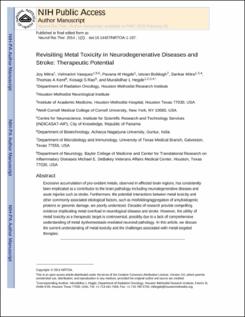| dc.contributor.author | Mitra, Joy | |
| dc.contributor.author | Vasquez, Velmarini | |
| dc.contributor.author | Hegde, Pavana M. | |
| dc.contributor.author | Boldogh, Istvan | |
| dc.contributor.author | Mitra, Sankar | |
| dc.contributor.author | Kent, Thomas A. | |
| dc.contributor.author | Rao, KS Jagannatha | |
| dc.contributor.author | Hegde, Muralidhar L | |
| dc.date.accessioned | 2020-07-03T22:08:11Z | |
| dc.date.available | 2020-07-03T22:08:11Z | |
| dc.date.issued | 2015-01-23 | |
| dc.identifier.other | 10.14437/NRTOA-1-107 | |
| dc.identifier.uri | http://repositorio-indicasat.org.pa/handle/123456789/170 | |
| dc.description | Excessive accumulation of pro-oxidant metals, observed in affected brain regions, has consistently been implicated as a ontributor to the brain pathology including neurodegenerative diseases and acute injuries such as stroke. Furthermore, the potential interactions between metal toxicity and other commonly associated etiological factors, such as misfolding/aggregation of amyloidogenic proteins or genomic damage, are poorly understood. Decades of research provide compelling evidence implicating metal overload in neurological diseases and stroke. However, the utility of metal toxicity as a therapeutic target is controversial, possibly due to a lack of comprehensive understanding of metal dyshomeostasis-mediated neuronal pathology. In this article, we discuss the current understanding of metal toxicity and the challenges associated with metal-targeted therapies. | en_US |
| dc.description.abstract | Excessive accumulation of pro-oxidant metals, observed in affected brain regions, has consistently been implicated as a ontributor to the brain pathology including neurodegenerative diseases and acute injuries such as stroke. Furthermore, the potential interactions between metal toxicity and other commonly associated etiological factors, such as misfolding/aggregation of amyloidogenic proteins or genomic damage, are poorly understood. Decades of research provide compelling evidence implicating metal overload in neurological diseases and stroke. However, the utility of metal toxicity as a therapeutic target is controversial, possibly due to a lack of comprehensive understanding of metal dyshomeostasis-mediated neuronal pathology. In this article, we discuss the current understanding of metal toxicity and the challenges associated with metal-targeted therapies. | en_US |
| dc.language.iso | en | en_US |
| dc.subject | Metal Toxicity | en_US |
| dc.subject | Neurodegenerative Diseases | en_US |
| dc.subject | Stroke | en_US |
| dc.subject | Therapeutic Potential | en_US |
| dc.title | Revisiting metal toxicity in neurodegenerative diseases and stroke: Therapeutic potential. | en_US |
| dc.type | Article | en_US |

